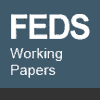
| Finance and Economics Discussion Series |
|---|
 |
Investigating the Sources of Default Risk: Lessons from Empirically Evaluating Credit Risk Models Gurdip Bakshi, Dilip Madan, and Frank Zhang 2001-15 |
Abstract: From a credit risk perspective, little is known about the distress factors
--
economy-wide or firm-specific -- that are important in explaining variations
in
defaultable coupon yields. This paper proposes and empirically tests a
family
of credit risk models. Empirically, we find that firm-specific distress
factors
play a role (beyond treasuries) in explaining defaultable coupon bond
yields.
Credit risk models that take into consideration leverage and book-to-market
are
found to reduce out-of-sample yield fitting errors (for the majority of
firms).
Moreover, the empirical evidence suggests that interest rate risk may be of
first-order prominence for pricing and hedging. Measured by both out-of-sample
pricing
and hedging errors, the credit risk models perform relatively better for
high
grade bonds. Controlling for credit rating, the model performance is
generally
superior for longer maturity bonds compared to its shorter maturity
counterparts.
Using equity as an instrument reduces hedging errors. This paper provides
an
empirical investigation of credit risk models using observable economic
factors.
Home | FEDS | List of 2001 FEDS papers
Accessibility
To comment on this site, please fill out our feedback form.
Last update: May 1, 2001